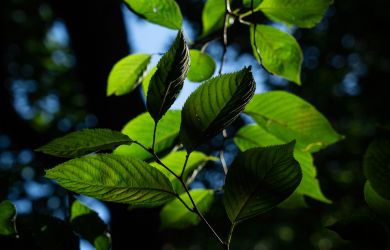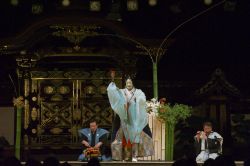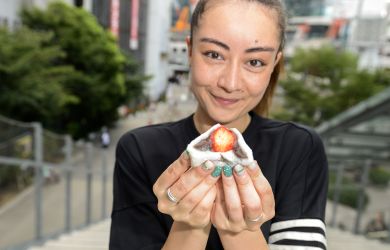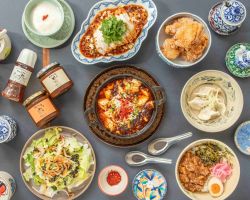
February 26, 2009
Going Native
Tokyo's thriving Ainu community keeps traditional culture alive
By Metropolis
Originally published on metropolis.co.jp on February 2009

Mina Sakai's wedding day
They are rough, hairy forest barbarians who hunt deer and catch salmon with primitive tools. They speak an alien tongue that no one even knows how to write. When one of their women get married, they make them tattoo their lips.
Though extreme, this is the view many “pure” Japanese hold of their cousins to the north—the Ainu.
Japan’s native peoples may have once conformed to this stereotype, but don’t be surprised if one of your colleagues, neighbors—or even the besuited, clean-shaven gent lining up every morning for the 8:39 express to Shibuya—is of Ainu descent.
The majority of Ainu remain in Hokkaido—a 2006 government survey put their numbers on Japan’s northern island at 23,782—and estimates in greater Tokyo range from 2,500 to 10,000. The true figure, however, could be much higher, as many Ainu lack the self-assurance to acknowledge their identity.
“The thing that hurt most about being Ainu was the self-loathing—I was negative about myself and thought I was ugly,” says Mina Sakai, the leader of the Ainu Rebels, a dynamic music ensemble of young Ainu performers.
Sakai, 26, was born in Obihiro, Hokkaido, to a Japanese mother and Ainu father. She says it took many years to come to terms with her identity and deal with the discrimination she faced in her hometown.
“There was strong prejudice against Ainu, especially in Obihiro, and I hid the fact that I was Ainu,” she tells an interviewer at the Ainu Culture Center, located a few blocks from Tokyo Station. “For example, when I went shopping, people accused me of shoplifting. Whenever I got into an argument with someone and they called me ‘Ainu,’ I wasn’t able to say anything back.”
While Sakai believes the situation has improved, she tells of a friend in Hokkaido who was turned down for a job because the interviewer took a dislike to her appearance. Ainu tend to be strongly built, taller then the average Japanese, with Caucasian features and more pronounced facial and body hair. Such discrimination has also been known to nip burgeoning young love in the bud. Indeed, as Sakai’s elder brother, Atsushi, also a Rebel, raps in one song: “One day my girlfriend told me over the phone, ‘Ainu people are creepy.’”
Despite having experienced discrimination due to her mixed parentage, Sakai embraces her Ainu identity. She likens the Japanese majority’s view of native peoples to the situation in the United States.
“Black people are seen as blacks. Even ‘halves,’ such as Tiger Woods, are seen as black,” she says. Sakai talks of two encounters—both of which occurred overseas—that emboldened her sense of Ainu identity.
“I visited a group of indigenous people on a high school trip to Canada,” she says. “They and their songs were cool and left a deep impression. They had such positive energy. This was when I realized I had a choice… I could be like them, there’s no shame in being an Ainu.”

Tonkori player Oki Courtesy of Chikar Studio
The second encounter was in 2003, when she met her husband, Lonnie, a half-Chinese American born and raised in Japan, on an exchange tour to Australia that involved a Kanto Ainu group and Australian aborigines.
“When I met Lonnie, he told me that I was fine just as I was,” Sakai says. “This freed me from any negative feelings I had.”
When the pair wed in Tokyo in April 2005, Sakai used black lipstick to recreate the traditional Ainu mouth tattoo—her way of reclaiming a sense of Ainu beauty and tradition that had been outlawed by the Japanese government.
It is believed that Ainu culture was established across Hokkaido, then known as Ezo, around the 12th or 13th century. The Ainu were hunter-gatherers who had their way of life decimated by the gradual migration of Wajin, as “mainland” Japanese were known. According to a government census, the number of Ainu in Hokkaido dropped from 26,256 in 1807 to 16,272 in 1873. It’s easy to figure out why.
When the Tokugawa shogunate took control of Ezo in the mid-1850s, the government attempted to pacify the Ainu by offering them trade and protection while assimilating them into the larger Japanese culture. The Ainu were forced to change their hairstyles and clothes, were banned from wearing earrings and tattoos, and were prohibited from religious customs such as performing the ceremony to return the spirits of bears—sacred in the Ainu religion—to the world of the kamuy (gods). Many Ainu were forced to work, essentially as slaves, for Wajin, resulting in the breakup of families and the introduction of smallpox, measles, cholera and tuberculosis into their community.
In 1869, the new Meiji government renamed Ezo as Hokkaido and unilaterally incorporated it into Japan. It banned the Ainu language, took Ainu land away, and prohibited salmon fishing and deer hunting. The enactment of the ironically named Hokkaido Former Aborigine Protection Law in 1899 removed even more land and further impoverished the Ainu.
In the first decades of the 20th century, some Ainu started to take a stand against the Wajin by calling for independence. Over the next half-century, various projects to redress disparities and preserve Ainu culture improved the lives of Japan’s indigenous peoples.
Despite these gains, Ainu continued to suffer from a prevailing ignorance. In 1986, Prime Minister Yasuhiro Nakasone infamously remarked, “Japan is a racially homogenous nation, and there is no discrimination against ethnic minorities with Japanese citizenship.” This comment infuriated and politicized many Ainu. In 1994, an activist named Shigeru Kayano became the first Ainu to win a seat in the Diet. Kayano pushed Ainu issues—even posing parliamentary questions in his native language—leading to the enactment of a law promoting aboriginal culture.





